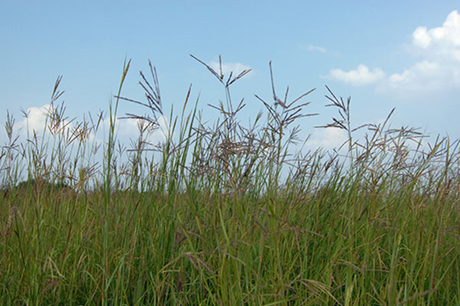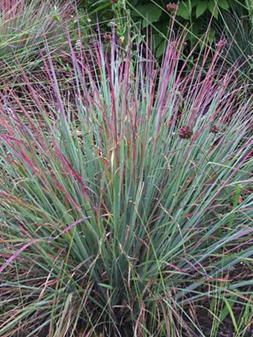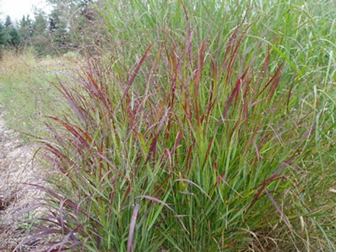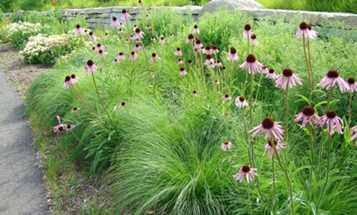OUR COMMITMENT TO CREATION
Prairie Grass - The Foundation of a Prairie, Part 1
Paula Tompkins, Land Stewardship member
What comes to your mind when someone says “prairie”? Tall grass? Wildflowers? In restoring the FUMC prairie, Land Stewardship has learned that prairies are much more than grass, with wildflowers, shrubs, pollinators, and birds. But grass is the foundation of a prairie. When white settlers moved into the Great Plains in the 19th century, there were over 150 different species of prairie grass. During August and September many grasses display their colors. If you walk the FUMC prairie trails starting in August, you can enjoy the understated beauty of prairie grasses.
One of the most important things about prairie grasses is something you do not see, their root system. Undisturbed roots of prairie grasses can grow up to 15 feet underground. The root system is why prairies can absorb water from heavy rainstorms, reducing flooding and soil erosion. These same deep roots help prairies survive seasons of drought. With the earth’s changing climate, Minnesota is experiencing more weather extremes, making prairies and their grasses important for protecting our land and even our homes. In addition, prairies pull carbon from the air, storing much of it in the root system. Carbon stored in roots is why the soil of prairies is so dark and rich. It is the root system of prairies, especially the grasses, that make prairies an important tool in how humans adapt to climate change.
So, what grasses can you find when you walk the prairie trails at FUMC? There are 8 different varieties of prairie grass growing throughout our prairie. Three varieties were here when our church moved to Pine Cone Road—Big Bluestem, Little Bluestem, and Switch Grass. Since then, Carl Bublitz has supervised planting or planted himself seeds of 5 more varieties of prairie grass—Indian grass, Kalm’s brome, Fox Sedge, Side Oats Grama, and Small Prairie Dropseed. This issue of Prairie Talk will focus on four of these grasses—Big Bluestem, Little Bluestem, Switch Grass, and Prairie Dropseed. September Prairie Talk will focus on the remaining four.

Big Bluestem is the tallest grass in our prairie, growing 4-8 feet tall. When you read about people getting lost in tall prairie grass, they were lost in Big Bluestem. Big Bluestem changes color during the growing season. Its foliage starts out blue green, slowly turning green, and then red bronze in fall. The root system can reach down more than 10 feet. Big Bluestem is important for nesting birds, such as meadowlarks, sparrows, and wrens. It also is a food source for butterfly larvae, especially skipper butterflies which are endangered in Minnesota because of the loss of prairies to development and agriculture.
Little Bluestem was once thought to be a close relative of Big Bluestem, but is now recognized as a different genus. It is a dense clumping grass with fine leaves that grow 3 to 4 feet, with roots growing 5 to 8 feet. Little Bluestem is a late season starter, with blue-green stems appearing in August, turning bronze in the fall and lasting all winter. Those are the clumps of prairie grass you see in the snow, providing habitat through the winter. Like Big Bluestem, Little Bluestem is important for nesting birds and is a food source for butterfly larvae, especially endangered skipper butterflies.


Switch Grass, one of the common deep-rooted grasses of tall grass prairies. It grows up to 8 to 10 feet, with a root system of 10 feet. It typically is shorter than Big Bluestem. The large purple-red seed heads of Switch Grass begin blooming in August. Switchgrass is cultivated by farmers for hay and pasture feed for cattle (not horses, sheep, or goats), biodegradable plastics, and as a bioenergy crop. In the prairie, switch grass is a groundcover for wildlife and larval food for butterflies.
Carl Bublitz has seeded Prairie Dropseed around the edge of the FUMC memorial garden, where the prairie comes up and meets the memorial garden. Prairie Dropseed is one of the dominant grasses of both the Tall and Short Grass Prairies. It has leaves 1 to 1 ½ feet tall with pink and brown blooms 3 feet tall. It also in larval food for six varieties of endangered skipper butterflies. Some say the scent of Prairie Dropseed blooms are like buttered popcorn.


